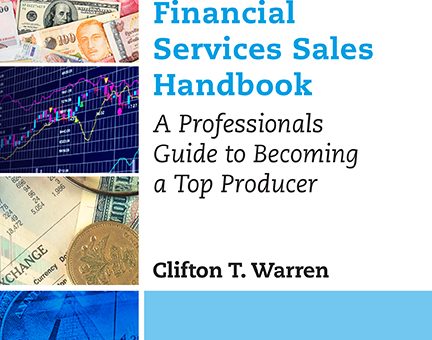
| September 2, 2016 | Comments Closed |
Book Review
A Must-Read for Success-Oriented Financial Services Professionals
By Roger C. Parker
Clifton Warren’s Financial Services Sales Handbook: A Professionals Guide to Becoming a Top Professional, is the new “go to” guide for financial services professionals, both newcomers to the field as well as experienced professionals looking to improve their game. It is, indeed, a “handbook,” in terms of step-by-step guidance for readers with differing levels of experience.
If you equate “handbook” with books containing page after page filled with type, you’ll be pleasantly surprise by the reader-friendly design of the pages. The book’s inviting design is the result of the carefully-crafted partnership between the way Clifton writes and the way he has included graphics throughout the book.
Clifton has a warm, but concise writing style. His writing demonstrates deep empathy and understanding of his readers, but his focus is on communicating practical, actionable information as economically as possible. He introduces new topics by explaining their relevance and the benefits they offer readers. He avoids abstractions, modifiers, and unnecessary words. His sentences are short. His paragraphs are short. He also uses frequent subheads to introduce new topics and lists to visually organize and present information surrounded by white space. He uses call-outs to emphasize key ideas or suggestions.
He also uses a variety of graphics to reinforce ideas and encourage reader engagement. He uses simple diagrams to illustrate relationships between ideas. He also uses cloud-like mind maps to progressively introduce details. There are also frequent tables to make it easy to compare information, and call-outs to emphasize key ideas or suggestions.
Most important, however, are the dozens of assessments, checklists, and worksheets found in the Financial Services Sales Handbook. The combination of Clifton’s constantly asking questions and providing space for readers to respond makes it easy for readers to immediately make the transition from “reading” to “action” and progress.
The Financial Services Sales Handbook is one of the most carefully organized business books I’ve encountered this year. Its craftsman begins with the way the 12 chapters are logically organized into four parts. These correspond to the four major tasks required for successful sales:
- Part 1: Laying the Foundation (3 chapters)
- Part 2: Getting More from Existing Clients (3 chapters)
- Part 3: Acquiring New Business (4 chapters)
- Part 4: Accelerating Growth (2 chapters)
Chapters are short and to the point. They explain the importance of tasks, followed by step-by-step “how to” descriptions of what to do. Tasks are accompanied with best practices, examples, and suggestions. Each chapter ends with a detailed summary of the information shared.
Chapter 2, Discovering Your Natural Prospects and Clients, contains a very revealing example of Clifton’s real-world orientation based on his years of fieldwork and training. The section, Managing Your Personal Contact List, contains a sample Personal Contact List Organizer which you can easily create using any spreadsheet program. Clifton is encouraging you to take immediate action using a simple, everyday software program, with the expectation that you may later advance to a more sophisticated contact management system later. Clifton is obviously aware that expecting readers to master a new software program while building their contact list is an invitation to frustration and procrastination.
To me, the above is the type of savvy, reader-friendly advice that reflects the spirit of Clifton Warren’s Financial Services Sales Handbook. This is truly a highly practical, actionable book for professionals who want to become top producers.
Another favorite example is Chapter 12, Personal Planning: Making Your Plans a Reality. It’s not only the longest chapter, but–by itself—I consider it almost worth the cost of the book. It helps you evaluate your beliefs and habits, create a plan for positive change. Table 12.2, Identifying Your Priorities, helps you relate your business priorities to other areas of your life. The chapter goes deep, anticipating obstacles you may encounter, and offering suggestions.
The Resources that follow can help you save time locating vendors. There’s also a section-by-section review of the main ideas in each chapter.
“I’m often present during the developmental editing stage of a book, when the book’s mission, “look and feel,” the table of contents, and the chapter structure is formalized into a writing plan and handed back to the author. Sometimes the book doesn’t turn out as well as I hoped. In this case, however, Clifton Warren and his team over-delivered, more than exceeding my expectations…and they were very high from the start.”
Roger C. Parker is a top-ranked Content Marketing Institute blogger and author of over 40 nonfiction books read by over a million readers in 37 languages. Learn more at Published & Profitable.




